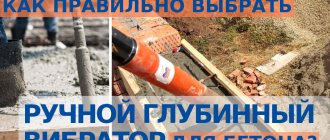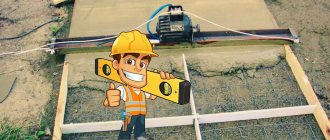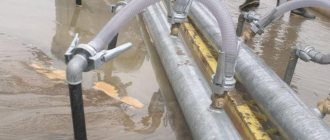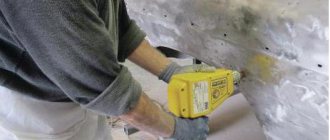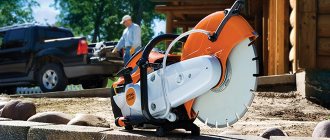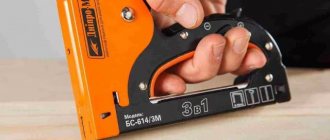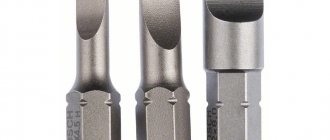March 11, 2021 Hand-held petrol tools, electric-pneumatic tools
The most important technological element in obtaining a durable monolithic concrete block after pouring the solution into the formwork is its compaction by squeezing out and displacing the remaining air. Previously, this was done by tamping the poured concrete or “bayoneting” - piercing with sharp pins. Modern monolithic construction technology uses a more effective method - vibration, under the influence of which the remaining air inside independently rises to the top. To create a vibration load, a special device is used - a concrete vibrator.
Purpose
The prepared concrete solution, despite thorough mixing, remains heterogeneous, which reduces the characteristics of the monolith. In addition to cement laitance, crushed stone and sand, it contains water and air bubbles.
If concrete is simply poured into the formwork, the result will be a structure that is heterogeneous in structure. The use of a vibration compactor for concrete increases the fluidity of the mixture without additional additives, due to the movement of its components. Air inclusions are pushed onto the surface of the monolith, and the fillers are evenly distributed throughout the volume.
After vibration compaction, the volume of concrete poured into the formwork is reduced by 30%. This effect occurs due to getting rid of air-filled voids and more dense packing of sand and crushed stone. As a result, the strength of the massive structure reaches its maximum value and high density for a given grade of concrete.
Deep
The devices create mechanical vibrations in concrete solutions. This significantly improves the adhesion of concrete to reinforcement. The devices directly immerse the mixtures immediately after they are poured into the formwork. A significant part of models of this type operate on a 220 V power supply. They can be used for industrial and domestic concreting work.
Advantages:
- good quality of mixture compaction;
- reliability;
- ease of operation and maintenance.
Flaw:
- high price.
Principle of operation
In private and industrial construction, a submersible vibrator is more often used; other models have similar operating principles. The design is based on a unit that creates vibration vibrations of a frequency sufficient to squeeze out air bubbles and foreign inclusions and compact the fillers.
In the design of vibrators, the main unit is a shaft with an eccentric, which is immersed in concrete. Rotates from a drive connected to a gasoline, diesel, electric or pneumatic motor. The rotation is transmitted through a strong but flexible steel cable. The shaft itself is located in a vibrating tip or mace - a steel cylinder and is attached to the end of a rotating cable covered with a sheath.
The source is a single or three-phase electric motor of 220 V or 42 V. There are portable models with rechargeable batteries. For large volumes of concrete, it is better to work with gasoline internal combustion engines. The most productive devices are connected to diesel engines; they are designed for compacting large masses of concrete.
Device: 1 - mace (vibrating tip), 2 - flexible shaft, 3 - drive
Types and characteristics
There are 3 types of concrete vibrators, differing in design:
- A deep vibrator immersed in a freshly poured solution. It is used in construction, when concreting large monoliths and foundations of buildings and structures.
- Platform vibratory compactors are used when pouring floors and roads. A surface vibrator is an oscillating plate or strip. By acting on the top layer, the slab compacts the entire monolith.
- External type vibrators are fixed to the formwork. They are often used in the construction of columns with dense reinforcement.
Vibrators differ in drive type:
- Electric - have a relatively small mass and work in any conditions. 220 volt vibrators have the lowest power, three-phase options are massive and require special conditions to provide power.
- With internal combustion engines - high-power petrol and diesel models. They are quite bulky and require professional maintenance, but can work on sites without electricity. Their high power makes it possible to compact large monoliths.
- Pneumatic models operate from a compressor, the force is transmitted through a high-pressure hose, and are used in reinforced concrete factories; they are not widely used in construction.
Based on power, portable vibrators are distinguished with motors up to 2 kW. They are inexpensive, do not require professional training to operate, and are suitable for private construction. Professional vibrators have a power of up to 4 kW, can operate for a long time, and are used in industrial construction, in the construction of monoliths and in the production of reinforced concrete structures.
In addition, vibrators are classified according to shaft rotation speed:
- Low-frequency models with shaft speeds up to 3500 rpm provide a large amplitude of the vibrating shaft. They are used for concrete with coarse-grained fillers that have low mobility.
- Mid-frequency devices up to 10,000 rpm, the most popular option with universal characteristics, are used to work with mixtures of varying degrees of mobility.
- High-frequency vibrating tools, a frequency of more than 10 thousand revolutions per minute, with a small amplitude, are suitable for moving mixtures with fine grain fillers. Ultrasonic models have a similar area of application.
These devices differ in shaft length, which can vary from 0.5 to 20 meters. This makes it possible to process volumetric monoliths, column foundations, and reinforced concrete structures. Submersible models come with a club diameter from 25 to 110 mm.
The thicker the reinforcement, the smaller the diameter of the club used.
Site
Centrifugal type devices. There are directional and circular area vibrators. The equipment compacts the concrete solution as much as possible in the production of floor slabs and other concrete horizontal surfaces of small thickness. The operating principle of the devices is based on the action of a plate on the top layer of the solution, generating mechanical vibrations.
Advantages:
- increasing the strength of concrete up to 20% while saving cement up to 15%;
- reduction of concrete hardening time.
Flaws:
- high energy consumption;
- high price.
How to choose?
At the first stage, the type of vibrating tool is selected - for screeds and other extended structures of small thickness, a surface type device is selected. The deep vibrator is widely used in construction work, when pouring foundations and other structures. External vibrators are used in the production of paving slabs; they are also necessary for compacting screeds and floors of relatively small thickness and large areas.
Another selection criterion is the power of the equipment, on which the time of its continuous operation depends. In private construction, the most popular are deep portable vibrators with a power of 0.8 to 1.5 kW. At dachas and other facilities where there is no centralized power supply, battery models can be used. In industrial construction, in the production of structures, devices for compacting reinforced concrete from 3 to 4 kW are more often used.
To obtain optimal mixture quality, the rotation speed must be taken into account. For concrete with coarse fillers, a low-frequency tool with a large vibration amplitude is used. If you use other models, the composition will separate and the quality will decrease. For private construction, it is better to choose a mid-frequency vibration compactor with a wide range of settings, suitable for solutions with different fractions of fillers. The high-frequency tool has a narrow specialization and is used for fine-grained concrete.
An important parameter is the weight of the equipment. For construction work on a personal plot, power tools weighing up to 6 kg are often purchased. Installations with higher power weigh up to 18-20 kg; this is semi-professional equipment used by private teams. The powerful professional tool weighs 90-100 kg and requires several people with special training to operate it.
When selecting a submersible vibrator, pay attention to the diameter of the tip (club), driven by a flexible shaft. Densely reinforced structures require vibrating tips with a diameter of 15 mm, options up to 50 mm are allowed. To compact a conventional unreinforced monolith, large diameters of up to 110 millimeters are used.
The choice also depends on the depth of the formwork. To use the vibratory compactor effectively, the drive tube must be 1 meter longer than this depth. This will leave freedom of maneuver, which is taken into account in the manufacture of vibration equipment.
The best venues
OLI MVE 500 15
Country of origin: Italy. Average cost – 32,000 rubles. The most popular model of the MVE series. The device is equipped with steel shafts that can withstand heavy loads. OLI MVE 500 15 can operate on 220 V and 380 V.
Characteristics:
- Power – 0.35 kW.
- Oscillation frequency – 1500 kol/min.
- Weight – 21 kg.
The device is designed for compacting bulk materials and concrete solutions. The model is widely used in the production of reinforced concrete products, as well as paving slabs and bricks.
Advantages:
- reliability;
- maintainability;
- long working life;
- high protection class;
- economical energy consumption.
Flaw:
- high price.
The manufacturer's warranty period is 12 months.
Review
| Yuri E. |
| The device justifies its price, but for large volumes of concreting there is not enough power. |
WACKER AR 36/6/042
Country of origin: Germany. The average cost is 10,000 rubles. The model is intended for industrial use. The vibrator is widely used in the production of reinforced concrete products and when pouring large volumes of concrete into formwork. Fastenings for mounting an external vibrator are not included in the equipment package. They must be purchased separately.
Characteristics:
- Power – 0.4 kW.
- Oscillation frequency – 6000 kol/min.
- Weight – 7.2 kg.
WACKER AR 36/6/042 is equipped with an LED sensor that controls the operation of the vibrator.
Advantages:
- ability to withstand thermal loads up to +180°C;
- compactness and mobility;
- work in safe mode 42 V.
Flaw:
- impossibility of use without formwork.
The manufacturer's warranty period is 12 months.
Review
| Mikhail O. |
| The model provides good compaction of concrete in the formwork. Easy to maintain and reliable in operation. |
DIY concrete vibrator
It’s easy to make a reliable and functional vibrator with your own hands; all you need is a suitable power tool with variable speed control. Its drive must be reliable so that the bearing can withstand the eccentric runout.
From a drill
To make an internal vibrator with your own hands, you can use a regular drill. The easiest way is to purchase a ready-made nozzle with a mace. Such drives that transmit force to the shaft can be found in stores that sell ready-made equipment.
Most models have a hexagon on the shaft. If not, an adapter is made that is clamped into the chuck. The protective casing is a tube with several holes into which bolts are screwed. They tighten, resting against the body, which is quite enough.
You can also make a mace yourself. To do this, take a metal cylinder on which the bearings are fixed. A steel rod is passed through them, onto which a weight is welded in the part located inside the cylinder, providing an eccentric. When working with shallow-depth monoliths, the flexible drive that transmits force to the vibrating tip can be replaced with a steel rod.
It is important to ensure the tightness of the structure.
From a hammer drill
This is the easiest way to make a deep concrete vibrator. Several rods are added to a regular lance to increase the processing area, and it must work with impact to create oscillatory movements. Such a vibrator is convenient in private construction, but it is difficult to use in reinforced massifs.
Using a scoop or trowel, you can make a surface vibrator for compacting concrete from a regular hammer drill. It is enough to place the rod on a scoop or trowel in impact mode and place them on the solution. After switching on, the top layer will begin to compact.
Surface vibrator
For a homemade vibrator for concrete screeds and other large surfaces, you can take any motor and attach an eccentric weight to the output axis. This design is mounted on a flat plank, maybe even a wooden one, to which a handle is attached. The bar is installed on the solution, and the vibrator is turned on, vibrations are transmitted from the upper layers to the bottom of the structure.
For what purpose?
Once you choose the type of vibrator you need, you can move on. If the use of compressed air energy seems most attractive to you, then you can choose a suitable pneumatic vibrator, guided by the article: Recommendations for the operation of FineTek pneumatic vibrators and pneumatic hammers.
If in your conditions it is most convenient to use electric motor vibrators, then the article “How to choose an electromechanical vibrator” will help you choose the right platform vibrator for your production tasks.
The issue of selecting a specific type of vibrator and the method of its installation is quite complex, so we decided not to simplify the information presented in these materials, but to give you the opportunity to independently understand the upcoming vibration process and its practical organization.

